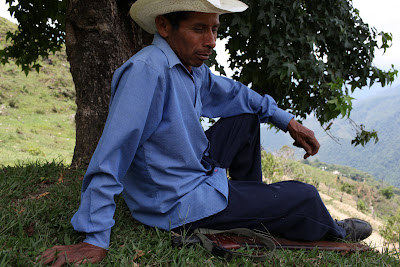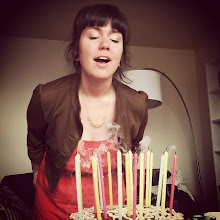
Marta´s mother at the kitchen table.

Cristina, Marta´s sister makes a stack of tortillas almost everyday. And she taught us how to make them! I would say we are officially tortilla-maker-masters, but unfortunately ours turned out super feas. Fugly, in other words.
Felix and Cristina took us to their farm. Many women farm in Sochiapan as well. As one of the women we interviewed, Marina, said, the farms take a lot of work. Of course they´re going to help out.

Takin´a rest. As we said, the hikes can be pretty tough.

A casa de maiz. They keep corn houses of mazorca - mature corn - out by their farms, to take back to their houses little by little.

And firewood! We crossed paths with cow above. Felix said the cow must be thinking what are they doing here?! We gringas felt pretty useless (firewood-less, of course) on our hike down. Kate carried Cristina´s empty purse, and Felix refused our offer to carry his machete. Luis, Cristina´s 10 year old nephew above (and big UNO aficionado as we found out) carried a machete of his own and a slingshot to try to hit birds with pebbles. Nice.

Cristina´s mother makes aprons... see her lovely models several pictures below.
These are the very traditional and beautifully embroidered Mahals that people still sometimes wear for special occasions. The woman on the left sews them by hand and said that each takes about 2 and a half months.

Marta and Cristina´s quite ancient grandmother with her walking stick. And without anyone´s help she still uses the latrine and bucket showers etc. There are five generations of the family alive right now. Angel - great great grandson and potentially the cutest child on the planet - is in the apron-modeling picture.
Cristina grinds the corn in a motorized molina. Her mother and grandmother used to grind it with a stone.
We went with Erica and her dad, Francisco, a neighbor and as we later learned a distant relative, of course, on a 2 hour speed hike each way. It would have been beautiful (and definitely was when it was just us and the kids on the way back) had we not been huffin and puffin the whole way there and looking at our feet so as not to slip on the mud. Here, Francisco is loading up the donkey.
The clouds often settled low with us high up above them.

Francisco spraying watered-down pesticide. When we went to interview him later, we realized that he doesn´t speak much Spanish; so we were really lucky that his wife was there - again, Marina - who talked about the importance of education, how she wished she had been able to continue with school, and how she hopes her children will.
The farming plots were mostly crazy vertical. Farming them seemed pretty impossible to us. See the tiny man farming in the distance? Crazy!


Modeling Margarita´s aprons! And that is Angel. As Nora pointed out, he kind of looks like the biker in Triplets of Belville when he was a little boy. Anyone? He was scared of us at first, but warmed up to us when we gave him a rubber toy frog - a super rad toy, actually. Everyone in the family says he´s always content and really sweet. His mom works up north in Monterrey, and he lived his first two years in Mexico City, so he speaks more Spanish than Chinanteco.
Please note the weird sweet bread (that we´ve come to know and love and eat daily) in this still- life painting that we saw in a road-side restaurant in Cuicatlan. The vans - colectivos - that go out into the mountains leave from Cuica... we didn´t expect a four hour semi-nauseating drive through the mountains, but it´s certainly better than no road at all! Just ten years ago, there was still no road, and it would take a full day for people from Sochiapan to walk into town to get whatever they needed. Marina said that most went barefoot, and their feet would bleed from the long hikes.
And last but not least - a full bag of super rico mangos for 20 pesos!!! ...$1.50
Here are exerpts from some of our interviews in Guanajuato. Please excuse the delay; we´ve had some technology ish.
Joel Hurtado Rosillo:
I am a primary education teacher, but I’m the son of a campesino, and I live in this community. So, for that reason, since I was little, there was also born in me this agricultural practice, I liked it. In my free time, after work – in the afternoons – I farm, and I also raise a lot of animals. I’m not an ejidatario, but I work part of my time in the farm plots, renting. Farming is nice. Unfortunately the costs of farming are very expensive. This year, we are trying to fertilize three times. But the cost is rising a lot…
And so what happens? Well that family stays very poor, always...That is the problem that the country has – if farming were modernized, it would be a different story. Because we have good land, good soil. But a lot of the time, a plant requires fertilizer, but the owner of the land does not have the means to buy it. What happens? Tomorrow, I´ll see if I can get it, and tomorrow I´ll see if I can get it, and tomorrow I´ll see if I can get it. The plant has passed its time for fertilization because the plant has already grown old.
Gerardo López Moreno:
We do farming on a contract basis, almost like the United States. All in contracts, as a matter of price – cost and benefit. I know that here, agriculture is more difficult than almost anywhere else in the world. There are no subsidies. Sometimes, people risking what little they have, soon enough won´t have anything. Yes, there are people, who have a guaranteed harvest, but very few. We have faith in the Lord. We have faith in God that nothing awful will befall us and take away everything here.
Gerardo López Moreno:
We do farming on a contract basis, almost like the United States. All in contracts, as a matter of price – cost and benefit. I know that here, agriculture is more difficult than almost anywhere else in the world. There are no subsidies. Sometimes, people risking what little they have, soon enough won´t have anything. Yes, there are people, who have a guaranteed harvest, but very few. We have faith in the Lord. We have faith in God that nothing awful will befall us and take away everything here.
Previously, the grocer there and those who are in towns like Acambaro and Selvatierra – there, there are people who comply, and who have been dedicated for a long time and run a good business selling corn. They bought ours. But there came a time here in Mexico, when, if the corn was worth two thousand pesos, they would say, well, give them one thousand five hundred. And so the farmer is really unprotected. There is no one regulating. Not even the government regulates.
The commercialization of corn is just starting to be regulated. Now they are fixing a price. They say to the vendors, ¨You know what? Who consumes the corn… the white corn?¨ We are producers and consumers of corn – we eat it. And we don´t like yellow corn, we like white corn. And the yellow corn is more nutritious, but we like the white. And so, because we are the only ones who consume white corn, it doesn´t have a price on an international level. And so either the government or the industrialists fix the price.









Ladies, these pictures are BEAUTIFUL! It looks like you're having so much fun and learning lots. I love reading your updates :)
ReplyDeleteYou are so punny! (couldn't resist...)
ReplyDeleteThanks so much for the love, ladies. It is so nice to see that peeps are actually reading our blog!
ReplyDelete